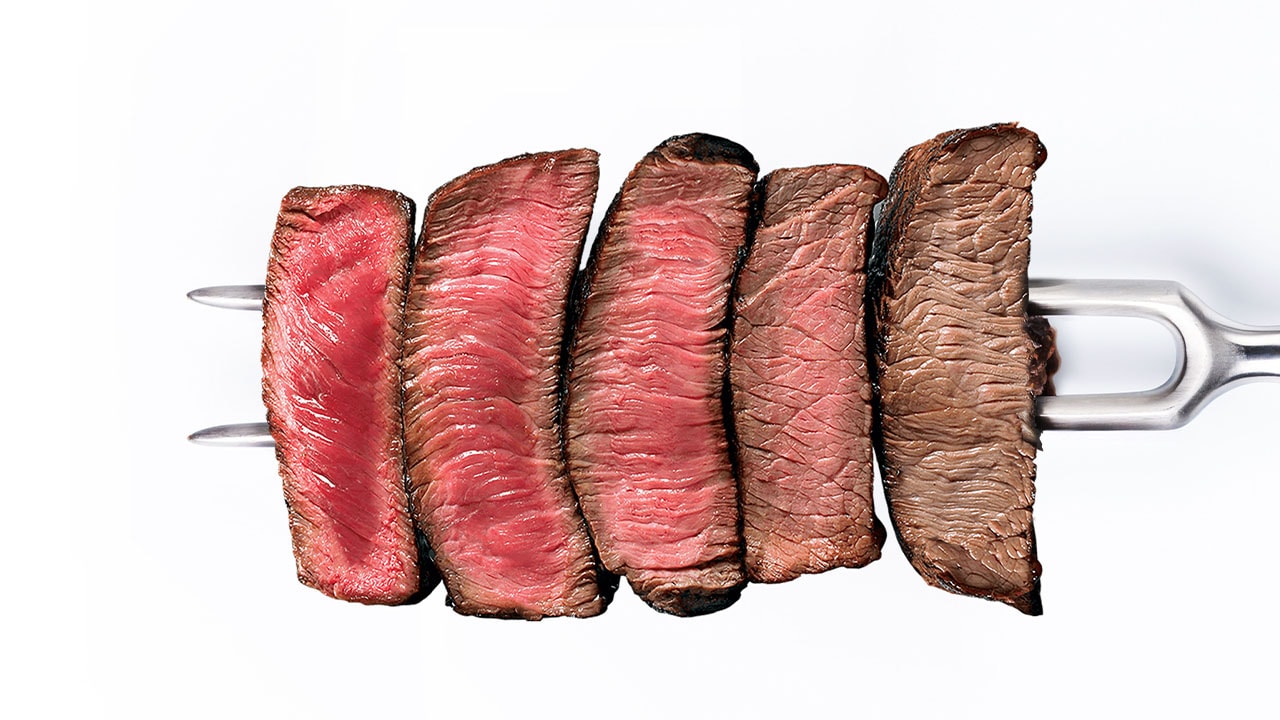ButcherBox’s Complete Guide to Grilling Steak
Cooking a steak to perfection is something anyone can do with the right preparation and tools. It also requires a good deal of patience—steak benefits from a period of post-grill resting—as well as an understanding of how to serve different types of steaks.
This steak-grilling guide walks you through everything you need to know. It teaches you:
- How to pick the best steaks to grill for intimate dinners, the family, or large gatherings
- How best to prepare your steak every time you spark up the grill
- What rules and steps to follow to get a steak to your preferred level of doneness, every time
- What mistakes to avoid when grilling steak
Mastering grilling a steak is an achievement many cooks aspire to from the moment they open the lid of their grill for the first time. With this guide, you’ll be able to plate a perfectly cooked steak that will impress family, friends, and any other guests that may show up in your backyard once the smell of grass-fed steaks wafts through your neighborhood.
How to Pick the Best Cuts to Grill
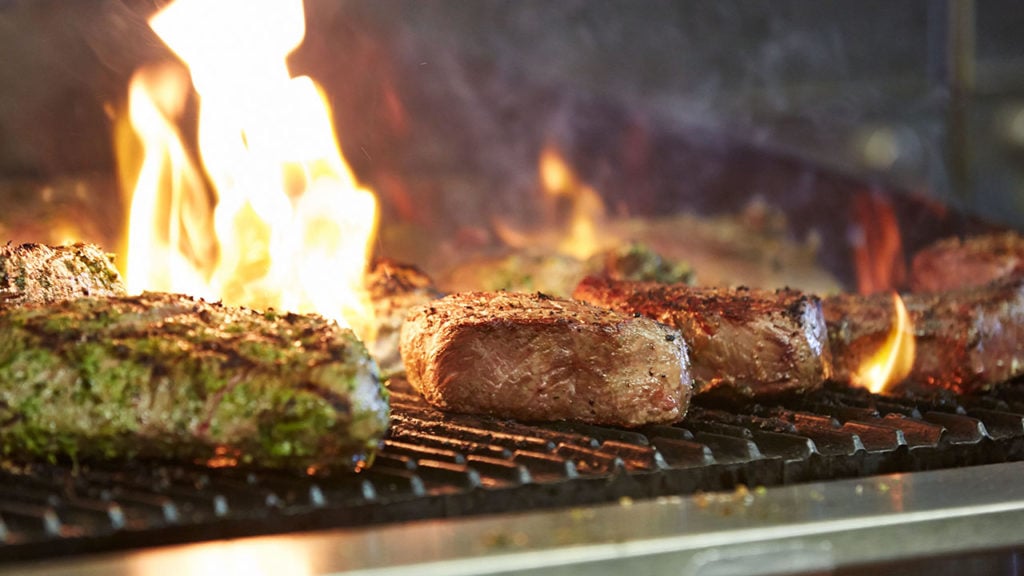
With so many steaks to choose from, how can you pick the right one? Luckily, no matter what steak you choose to grill, you’re in for an amazing meal.
Here is a breakdown of some of the most common steaks to grill:
- Ribeye steak – Grilled ribeyes are so tender and tasty. A ribeye is mouthwatering-good when grilled with just kosher salt or sea salt and fresh ground black pepper for seasoning; it has more marbling—even grass-fed and grass-finished ribeye steaks—than most other cuts.
- Filet mignon – Filet responds well to high heat and fast cooking preparations, so the grill is the perfect way to cook this cut. Filet mignons are typically served rarer than other cuts, but also usually have a nice char to them. They’re perfect for date nights and intimate dinners.
- New York strip steak – NY strip steak is a popular cut to grill that has a thin strip of fat running down one side. It dry-ages well, cooks quickly, and can be seasoned with just salt and pepper. However, it will benefit from a bit of marinating beforehand.
- Top sirloin steak – A top sirloin is a quick and easy steak to prepare. It doesn’t have the same reputation as the three steaks above but can be just as tender and flavorful if cooked right. They are also the perfect size to cook a few of to feed a family.
- Steak tips – Another good option to grill for large gatherings, steak tips are more often found in the eastern United States. Steak tips come from different cuts and are best when marinated and grilled on a skewer. Often, steak tips get confused tri-tips, which are a larger roast that can also be cooked on the grill.
- Other grilling steaks – We also love to grill some other steaks such as coulotte, flank steak, skirt steak, and flat iron steak. Many of these steaks are either a bit thicker or thinner than the steaks mentioned above, so they require different preparation (marinating), cooking, and cutting methods. These steaks are also perfect for grilled steak sandwiches, steak tacos, steak salads, and other grilled-steak-centric dishes.
Choose Your Steak Grilling Seasonings, Rubs, & Marinades
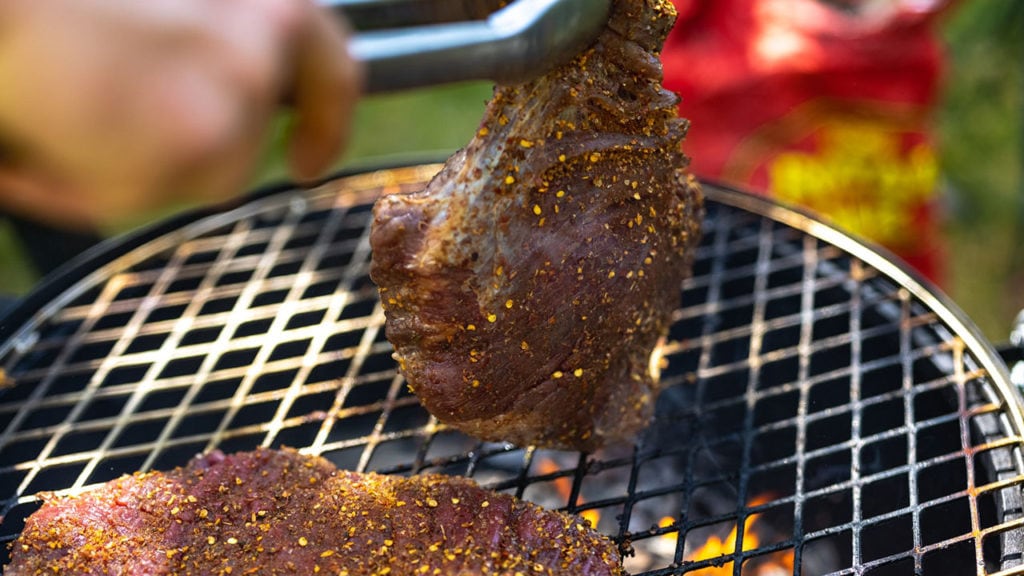
Keep these steak seasoning options in mind when preparing to grill and flavor your steak.
Most grass-fed steaks are so tender, they need little more than kosher salt or sea salt and freshly ground black pepper to make them explode with flavor.
But even these cuts of beef are enhanced by spending a bit of time in a savory and healthy marinade. Give a ribeye a half-hour in a balsamic vinaigrette or any number of red wine-based healthy grilling marinades, cover a NY strip steak in a quintessential rub overnight, or marinate and cover a top sirloin with chimichurri; all of these approaches will lead to an amazing transformation for any steak.
What are the best ways to season a steak? Here are some of the more common:
Tools Needed to Achieve Steak-Grilling Mastery
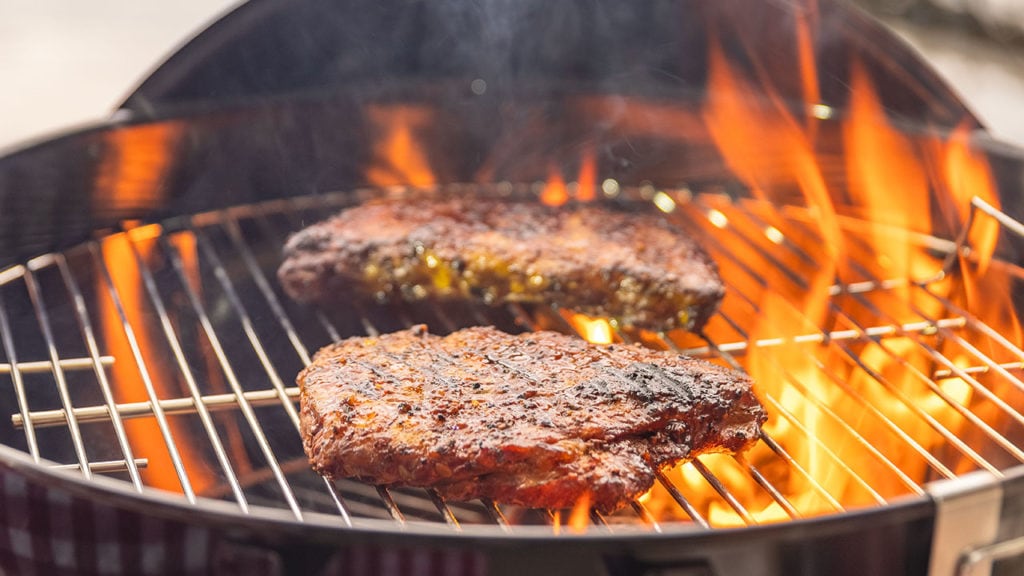
Whether you prefer the characteristic char of a charcoal grill or the ease and convenience of a gas grill, there are some key tools you’ll need to get the most out of your grilling escapades.
Start by getting these basic tools for grilling steak:
- Long-Handled Spatula or Tongs
- Wire Grill Brush
- Meat Thermometer
- Grill Basket
- A Chef’s Knife, Paring Knife or Carving Knife
- Wooden Cutting Board
You can learn about them in detail in our article, 7 Handy Essentials for Outdoor Grilling.
First and foremost comes the grill selection.
There’s nothing like the characteristic flavor of food cooked on a charcoal grill. Charcoal burns hotter than gas, and you can create direct and indirect heat areas pretty easily.
However, gas grills are more convenient, easy to clean, and make easy work of grilling a steak. Both allow you to whip up deliciously smoky and charred steaks.
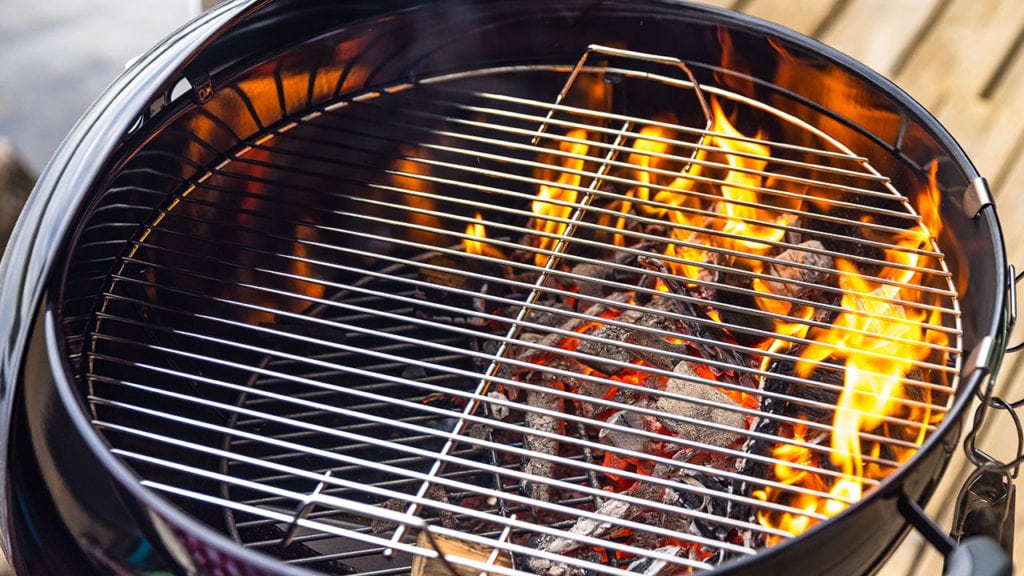
Here are the three tools that will help you most when grilling a steak:
- Tongs – a spring-loaded, long-handled pair of tongs will allow you to pick up, rotate, and turn nearly any-sized piece of beef without burning yourself or ruining the steak.
- Meat thermometer – An instant-read meat thermometer will let you best gauge a grilled meat’s doneness. A good one will read off your meat’s internal temperature (give or take a few degrees) within seconds. We love the Thermapen instant-read thermometer.
- Chef’s knife and cutting board – In reality, you need a few different knives to accomplish most of your grilling needs, but a chef’s knife will perform the brunt of the work—chopping, dicing, peeling, and smashing. Pair with a quality wood cutting board—more durable than a plastic one in the long run.
The Basics of How to Grill Steak
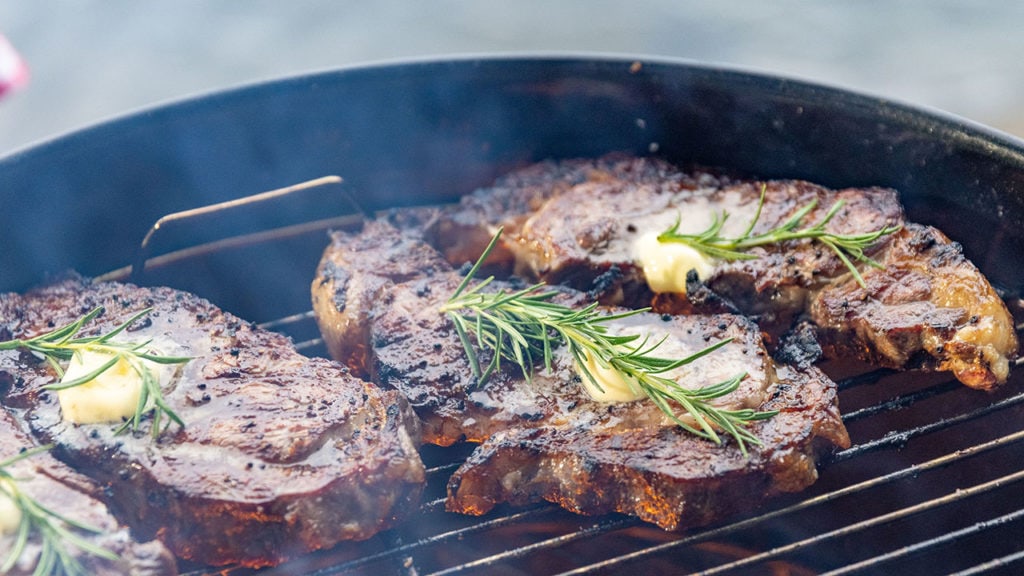
Now that you have your tools and a better idea of what you’ll be cooking, it’s time to cook your steaks on the grill. A few more steps and some quality time watching your steaks sizzle is all that stands between you and the perfect grilled steak.
How to Prep Your Grill for Cooking Steak
First, warm up your grill. If you are using a charcoal grill, let the coals get white-hot and wait for the flames to die down. A gas grill usually takes about 10 minutes to heat up so the grates are perfect to sear any steak.
Next, rub the grill down with an oil-soaked rag (vegetable or grapeseed oil are likely best, but olive oil can be used in a pinch), held with a pair of tongs. This will make sure that nothing sticks to the grill.
How to Grill a Steak to Perfection
Cooking time for your steak will depend on its size. Generally, for a one-inch-thick steak, grill for around 4 to 5 minutes per side.
On a charcoal grill, two techniques are to sear or reverse-sear it with two heat zones. To sear, grill first on high heat then finish on indirect heat. This creates a more crispy outer edge. To reverse sear, cook on indirect heat first and then move to direct heat to sear-finish, which will lead to a more evenly distributed level of doneness across the surface area of the steak.
With a gas grill, you can adjust the heat so that you don’t overcook, and also you can manually create different heat zones. Once you sear each side on the hot grates, you’ll want to slightly turn down the heat on that section of the grill so it doesn’t continue to cook on high heat.
Doneness Levels of Grilled Steaks
One of the most important parts of the grilling process is to make sure the steak is cooked to the proper doneness. The best way to make sure you’ve properly cooked your meat is by using a meat thermometer to gauge the internal temperature.
The key to getting your desired doneness is to remove the steak when it is about five degrees cooler than the recommended temperature. If you like a medium-rare steak, which is done at an internal temperature of 135°F, you should remove it at 130°F and let it rest. Be sure to review the USDA’s safe minimum internal temperatures chart for more information.
For other doneness levels, check out our guide for the proper cooking temperatures for different kinds of meat for reference.
Rest a Grilled Steak and Slice It the Right Way
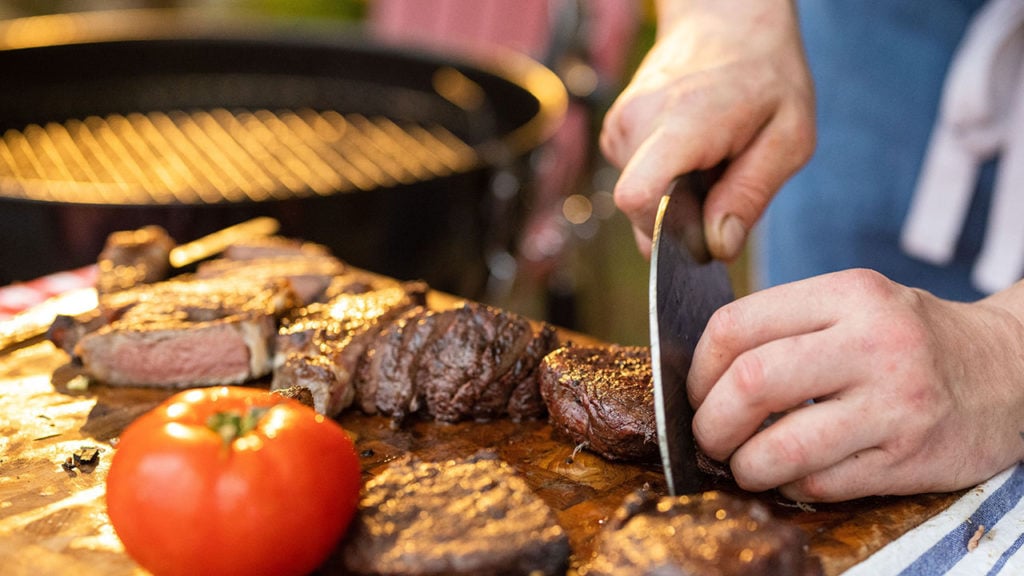
It’s important to know that beef will continue to cook for a bit after it is removed from a hot cooking surface. Following the direction above to remove a steak a few degrees before the desired doneness temperature, let your steak rest on a cutting board for between eight to ten minutes after removing it from the grill. This will allow it to also cook more evenly throughout.
Finally, make sure to cut your steak correctly. There are a few cuts that will be tougher to eat if you don’t cut it against the grain. Don’t ruin your steak by slicing it wrong.
How to Grill a Frozen Steak
There are many debates about cooking frozen meat. Conventional wisdom holds that it is ideal to let meat thaw before cooking, but experiments with cooking frozen meats have shown that there is often no difference in the results from doing this.
It will, however, take a lot more time to cook a frozen steak to your preferred level of doneness. So be prepared to wait a bit if you are throwing some frozen cuts on a grill.
Additionally, make sure you know the rules for defrosting frozen meat before you grill a steak that has been frozen.
Guide To Grilling Steak
Table of Contents
Best Steaks to Grill
- The Ribeye Steak – Our Favorite Steak to Grill
- Everything to Know About Filet Mignons
- All About NY Strip Steaks
- Ultimate Guide to Top Sirloin Steak
- What to Do With Steak Tips
Getting Ready to Grill Steak
- Our Favorite Grilling Marinades and Rubs
- Chimichurri Steak Sauce is Easy
- The Sauces to Serve with Any Steak
- Essential Tools for Grilling a Steak


